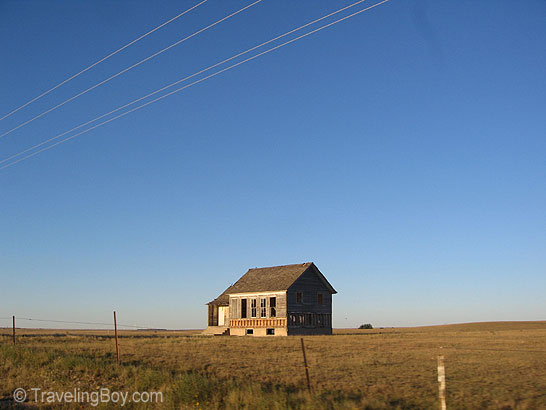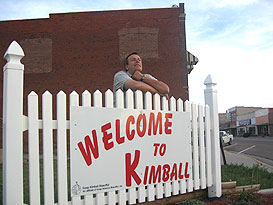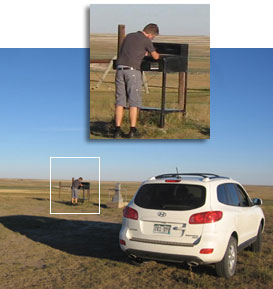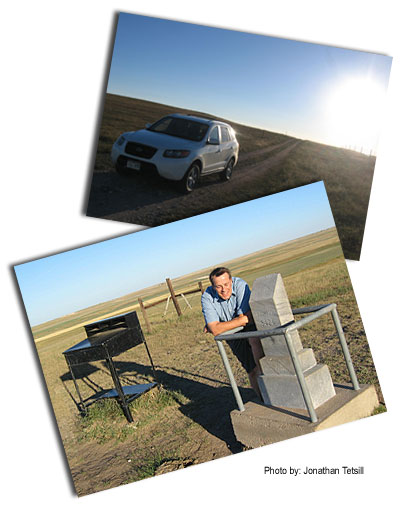 |
 |
|
 |

|
Conquering Nebraska's
Yet years later, I was reminded of one of those minutiae of state trivia gleaned from my school texts when I stumbled across a strange little travel guide in my local bookstore. It was a guide to state high points. Of course, now I remembered: every state was always presented with the statistic of its highest and lowest elevations. I always remembered this because I felt pretty sore at the time that my own state's Mount Rainier (14,410') was humbled by a mere dozen boulders into a lower rank due to California's Mount Whitney (14,505') and Colorado's Mount Elbert (14,440'). So I was intrigued and picked the guide up. Now, if you assume that this is a mountaineering guide with instructions on how to scale the glaciers of Alaska's Denali (20,320') or the other high peaks mentioned above, then you would be correct. At least partially: these glacial peaks are only one side of the spectrum. And as I'm no mountain climber such instructions on how to climb a glacier or rocky moraine weren't the really interesting part or my cup of tea (I'd never hiked more than 10 feet above the visitors' center and gift shop at Mount Rainier National Park). No, what was fascinating was just how 'low' and completely unimpressive so many of these 'high' points actually were, and yet were presented with separate chapters and equally serious detailed instructions as the higher peaks. Even more intriguing: instead of requiring rope gear and oxygen tanks, many of these were accessible by your very own car. Florida's Britton Hill (345' was at the edge of a parking lot in a little park, Louisiana's Driskill Mountain (534') on the grounds of a local church, and Delaware's highpoint (448') was either along the side of the highway or in the middle of the next door trailer park (but this didn't really count as the park had been raised a few feet due to flooding). So, why on earth issue a travel guide to such places? As it turns out, 'Highpointing' has it's following, with clubs, websites and even annual conventions dedicated to those whose goal in life is to reach all fifty summits, or at least as many as the road can take them to.
That's how I ended up at Nebraska's 5,429' Panorama Point last September. I was already going to Denver with my friend Jonathan from Cornwall, UK to do a Rocky Mountain road trip and I noticed Panorama Point was just a few hours to the east, just a mile from the Colorado state line. The Great Plaines start at mile high Denver and then gradually slope downward, losing a few feet per mile until you reach the Mississippi. It's no coincidence then that the high points for both the Dakotas, Nebraska, Kansas and Oklahoma are all located within a few miles of their western borders: if you moved these states' borders a few miles to the west they'd all end up with new highpoints. Jonathan was a good sport and up
for this eccentric little detour to the southwest corner of the Nebraska
Panhandle. We headed across the plains to the little town of Kimball
whose chamber of commerce had done an excellent job promoting their
county's greatest claim to fame. The sun ducked behind a cloud as we approached the peak, adding a somber, otherworldly feel to the utterly empty place. That we hadn't seen another human soul the entire trip reminded us that our destination was, well, a rather quirky one: a far cry from such heavily trotted tourist paths of say a Venice or a Cancun. The presence of bison added to the Wild West feel: the peak is located in the midst of a vast private bison preserve whose owners request a small honor system donation to leave at the unguarded entrance.
There's not much more left to say
about Panorama Point: you drive up to the official high point marker
and the registration box next to it to record your presence onto their
log, and that's it. It's even hard to tell you are anywhere much higher
than the surrounding terrain: it was global positioning, not any real
visual gradient that determined that this spot was the place. With nothing
around but the wind, the grasses, the sky and the bison, you are utterly
alone and at peace with the world. It's the journey, not the destination
which is so often the case. So perhaps it was no coincidence
that the very next day we found ourselves at a hitherto unscheduled
visit to Mount Sunflower down in Kansas (elevation 4,039'). But that's
another story.
|
|
Nice article (on Iceland). And by the other feedback, I see that others recognize you as a Eurovision expert as well. Perhaps Traveling Boy readers would enjoy your Eurovision/Iceland profile in New Geysir (it's called Can Music Save Iceland): http://www.icelandseattle.com/images/December_Final_Printers_Proof.pdf Kelly
James, Enjoyed your Eurovision article. I had read a bit about it in the past, but this filled in a couple of holes. I'm still a little confused, though, about a couple of things. I recently saw Celine Dion in Vegas, and know she is from (as you mentioned in your article) Quebec. Yet she was hired by Switzerland to sing. Can any nation hire anyone from another nation to represent their country, even though it is not a European nation? Also, I read that Israel is one of the countries that participates, yet they are certainly NOT in Europe. Can you explain? Barry Garcia * * * * * Hi Barry, Thanks so much for your feedback and for reading my article. And thanks for taking the time to write me. Very very good questions. The rules state that 'each nation's television station will select a 3 minute, original song to represent their country. There is no rules stating that the singer, the song writer or the lyricist have to actually be from that country. Small countries especially sometimes hire more popular singers to represent them and we have even sing the same artist sing for 3 different countries. An American friend of mine wrote this year's Czech entry. As for participating countries, Eurovision is organized by the European Broadcasting Union which is sort of a pan-European broadcaster. Any country that is a member can take part. It just so happens that a lot of countries around the Mediterranean also belong, even though they are not in Europe. Israel is one of them. Morocco once took part too. I asked that very same question to a member of the Israeli delegation once and they were really offended. Australia is also a member too and they broadcast it every year. Technically they could participate too, but given that it's a live event they have never elected to do so. Here is a link of our lovely Celine back in 1988, before her makeover and any of her English hits (at the next year's contest in Switzerland she debuted her first English language hit 'Where does my heart beat now' as part of the opening of that year's contest (but not as a participant). http://www.youtube.com/watch?v=8pEYw8PcBas&feature=related And here is the very exciting voting showing her win. One of the best ever http://www.youtube.com/watch?v=QNu-yXv6J5U Best regards,James
|
This site is designed and maintained by WYNK Marketing. Send all technical issues to: support@wynkmarketing.com

|















